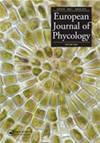Regional microbiome differentiation of the invasive Sargassum muticum (Fucales, Phaeophyceae) follows the generalist host hypothesis across the North East Atlantic
IF 1.7
4区 生物学
Q2 MARINE & FRESHWATER BIOLOGY
引用次数: 1
Abstract
ABSTRACT Over 90% of introduced marine species are seaweeds. Seaweeds rely on their microbiome for host settlement, nutrition, development and health. As such, it is likely that microbiomes are involved in seaweed invasions. Sargassum muticum, indigenous to Southeast Asia, inhabits the North-east Atlantic from Norway to Morocco. This is the only known successful case of a non-clonal marine invader with almost no genetic variation over its large NE Atlantic introduced range. This makes it a very interesting model to study an invasive seaweeds microbiome, as it practically uncouples host genetic variation from microbiome variation. Associated bacteria potentially contribute to the plasticity and acclimation of S. muticum leading to its success over the last 50 years. Dispersing host organisms can either bring their acquired microbes along or obtain new ones locally, following the mutualist and generalist host hypothesis, respectively. We used partial 16S rRNA gene amplicon sequencing to characterize the total and core microbiome across S. muticum structures/tissues from five NE Atlantic regions, from Norway to Morocco, covering over 30° of latitude. In contrast to host genotypes, highly diverse, regional, total and core microbiomes, with differentiation levels depending on tissue, bacterial community structure were detected. Atlantic S. muticum follows the generalist host hypothesis, possibly recruiting a new microbiome in each new region. This host promiscuity may promote the invasiveness of S. muticum. Diversity was lower in the young/annual tissues compared with the older tissues for the total bacterial community, suggesting that these are mostly transitory bacteria accumulating over time in the older parts. The total core microbiome included 10 OTUs, representing dominant community members commonly found in other seaweeds’ cores. The core Granulosicoccus OTU followed a clear regional pattern where northern and southern regions clustered differentially, suggesting a regional signature even at an OTU level. HIGHLIGHTS North-east (NE) Atlantic Sargassum muticum microbiome differentiation does not match host genetic background. NE Atlantic S. muticum shows a geographic region and tissue-specific total and core bacterial community matching bestthe generalist host hypothesis. Core OTU – the bacterium Granulosicoccus – shows a strong regional specialization.东北大西洋入侵马尾藻(Fucales, Phaeophyceae)的区域微生物组分化遵循通才宿主假说
摘要90%以上的引进海洋物种是海藻。海藻依靠其微生物组来进行宿主定居、营养、发育和健康。因此,微生物群很可能参与了海藻的入侵。马尾藻原产于东南亚,栖息在从挪威到摩洛哥的东北大西洋。这是已知的唯一一个非克隆海洋入侵者在其东北大西洋大范围内几乎没有遗传变异的成功案例。这使得研究入侵海藻微生物组成为一个非常有趣的模型,因为它实际上将宿主遗传变异与微生物组变异脱钩。在过去的50年里,相关细菌可能有助于S.muticum的可塑性和适应性,从而使其取得成功。分散的宿主生物可以携带它们获得的微生物,也可以在当地获得新的微生物,分别遵循互惠宿主假说和广义宿主假说。我们使用部分16S rRNA基因扩增子测序来表征从挪威到摩洛哥的五个东北大西洋地区,覆盖30°以上纬度的多分枝杆菌结构/组织的总微生物组和核心微生物组。与宿主基因型相反,检测到高度多样的、区域性的、总的和核心的微生物群,其分化水平取决于组织和细菌群落结构。Atlantic S.muticum遵循广义宿主假说,可能在每个新区域招募一个新的微生物组。这种寄主的混杂性可能会促进多菌的侵袭性。与老年组织相比,年轻/一年生组织的细菌群落多样性较低,这表明这些细菌大多是随着时间的推移在老年部分积累的短暂细菌。总的核心微生物组包括10个OTU,代表其他海藻核心中常见的优势群落成员。核心颗粒球菌OTU遵循明显的区域模式,北部和南部区域差异聚集,表明即使在OTU水平上也存在区域特征。东北(NE)大西洋马尾藻多微生物组分化与宿主遗传背景不匹配。NE Atlantic S.muticum显示了一个地理区域和组织特异性的总细菌群落和核心细菌群落,与广义宿主假说相匹配。核心OTU——颗粒球菌——显示出强烈的区域特化。
本文章由计算机程序翻译,如有差异,请以英文原文为准。
求助全文
约1分钟内获得全文
求助全文
来源期刊

European Journal of Phycology
生物-海洋与淡水生物学
CiteScore
4.80
自引率
4.20%
发文量
37
审稿时长
>12 weeks
期刊介绍:
The European Journal of Phycology is an important focus for the activities of algal researchers all over the world. The Editors-in-Chief are assisted by an international team of Associate Editors who are experts in the following fields: macroalgal ecology, microalgal ecology, physiology and biochemistry, cell biology, molecular biology, macroalgal and microalgal systematics, applied phycology and biotechnology. The European Journal of Phycology publishes papers on all aspects of algae, including cyanobacteria. Articles may be in the form of primary research papers and reviews of topical subjects.
The journal publishes high quality research and is well cited, with a consistently good Impact Factor.
 求助内容:
求助内容: 应助结果提醒方式:
应助结果提醒方式:


